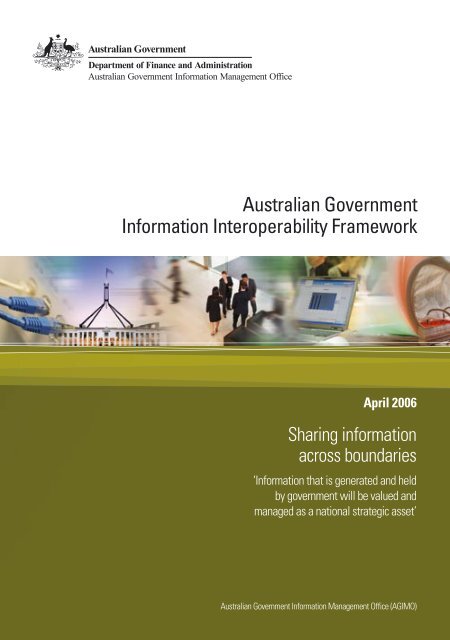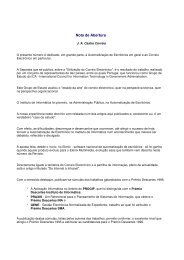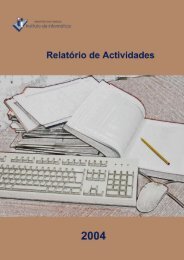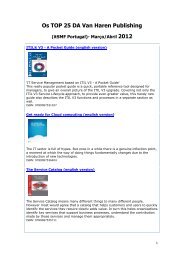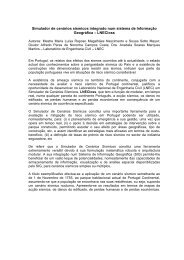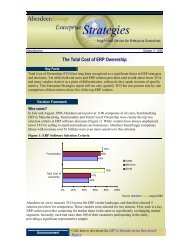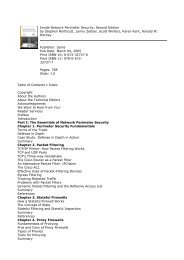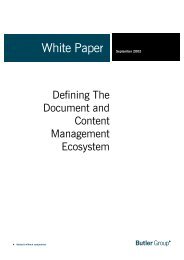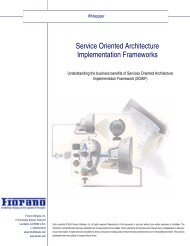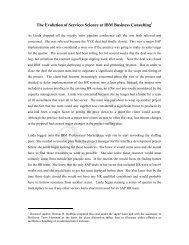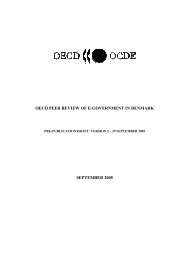Australian Government Information Interoperability Framework (pdf
Australian Government Information Interoperability Framework (pdf
Australian Government Information Interoperability Framework (pdf
You also want an ePaper? Increase the reach of your titles
YUMPU automatically turns print PDFs into web optimized ePapers that Google loves.
<strong>Australian</strong> <strong>Government</strong><strong>Information</strong> <strong>Interoperability</strong> <strong>Framework</strong>April 2006Sharing informationacross boundaries‘<strong>Information</strong> that is generated and heldby government will be valued andmanaged as a national strategic asset’<strong>Australian</strong> <strong>Government</strong> <strong>Information</strong> Management Office (AGIMO)
ISBN: 1 921182 10 5
<strong>Australian</strong> <strong>Government</strong><strong>Information</strong> <strong>Interoperability</strong> <strong>Framework</strong>
<strong>Information</strong> <strong>Interoperability</strong> Working GroupThe <strong>Information</strong> Management Strategy Committee (IMSC) presented the Chief<strong>Information</strong> Officer Committee (CIOC) with the task of addressing the informationdimensions of the <strong>Australian</strong> <strong>Government</strong> <strong>Interoperability</strong> <strong>Framework</strong>. The CIOC’s<strong>Information</strong> <strong>Interoperability</strong> Working Group was formed from representatives of arange of <strong>Australian</strong> <strong>Government</strong> agencies. They have worked together to develop the<strong>Information</strong> <strong>Interoperability</strong> <strong>Framework</strong>, outlined in this document. The frameworkprovides practical guidance for achieving the successful transfer of information acrossagency boundaries.The following agencies are represented on the <strong>Information</strong> <strong>Interoperability</strong>Working Group:• Attorney- General’s Department• <strong>Australian</strong> Bureau of Statistics (Chair)• <strong>Australian</strong> Customs Service• <strong>Australian</strong> Taxation Office• Centrelink• Department of Agriculture, Fisheries and Forestry• Department of Defence• Department of Education, Science and Training• Department of Employment and Workplace Relations• Department of Family and Community Services• Department of Finance and Administration, <strong>Australian</strong> <strong>Government</strong> <strong>Information</strong>Management Office• Department of Health and Ageing• Department of Immigration and Multicultural Affairs• Department of Industry, Tourism and Resources• Department of Veterans' Affairs• Geoscience Australia• National Archives of Australia• South Australia State <strong>Government</strong>, Department for Administrative and<strong>Information</strong> Services.
ContentsThe <strong>Information</strong> <strong>Interoperability</strong> <strong>Framework</strong>: Introduction 3The <strong>Information</strong> <strong>Interoperability</strong> <strong>Framework</strong> diagram 4C O N T E N T SWhy do we need an <strong>Information</strong> <strong>Interoperability</strong> <strong>Framework</strong>? 7The drivers 9The benefits 9Adopting the framework 9<strong>Information</strong> <strong>Interoperability</strong>: the vision 11What is ‘information’? 13Who owns information? 15<strong>Information</strong> management principles: the foundation for <strong>Information</strong><strong>Interoperability</strong> 17The information lifecycle 18Enabling <strong>Information</strong> <strong>Interoperability</strong> as part of the information lifecycle 19Barriers to <strong>Information</strong> <strong>Interoperability</strong> 20<strong>Information</strong> <strong>Interoperability</strong>: the enablers 231. Partnerships that work in a spirit of collaboration 252. A ‘create once, use many’ approach using authoritative sourcesof information 273. Common business language and standards 284. Appropriate governance arrangements 305. An understanding of the legal and policy framework 326. Tools that support information sharing 34Appendices 37Appendix A: The <strong>Information</strong> <strong>Interoperability</strong> checklist 38Appendix B: Resource/reference list 41<strong>Information</strong> <strong>Interoperability</strong> <strong>Framework</strong> Sharing information across boundariesiii
one Introduction: The <strong>Information</strong><strong>Interoperability</strong> <strong>Framework</strong>
The <strong>Information</strong> <strong>Interoperability</strong> <strong>Framework</strong>‘<strong>Information</strong> interoperability’ may be described as: ‘the ability to transfer and useinformation in a uniform and efficient manner across multiple organisations andinformation technology systems’.O N E I N T R O D U C T I O NIntroductionA key theme of <strong>Australian</strong> <strong>Government</strong> policy is that agencies should work togetherto better respond to complex policy challenges and to improve the delivery of servicesto <strong>Australian</strong> citizens. Agencies are increasingly required to reach across portfolioboundaries to find collaborative, networked and multi-channel approaches todelivering information and services. This expectation is clearly articulated in the FourthManagement Advisory Committee (MAC4) 2004 report, Connecting government: wholeof government responses to Australia’s priority challenges.Improving the capability of agencies to confidently manage, transfer and exchangeinformation is critical to achieving the benefits of ‘connected’ government. The<strong>Information</strong> <strong>Interoperability</strong> <strong>Framework</strong> aims to assist agencies to improve their capacityfor information management, in support of information exchange.The <strong>Information</strong> <strong>Interoperability</strong> <strong>Framework</strong> identifies those components that supportan environment where information that is generated and held by government willbe valued and managed as a national strategic asset. The framework provides theprinciples that underpin sound information management and establishes the concepts,practices and tools that will drive the successful sharing of information acrossgovernment boundaries.For ease of reading, the term ‘information’ has been used throughout thedocument and includes data. The term ‘data’ is used only when specific referenceto data is required.<strong>Information</strong> <strong>Interoperability</strong> <strong>Framework</strong> Sharing information across boundaries
O N E I N T R O D U C T I O NThe <strong>Information</strong> <strong>Interoperability</strong> <strong>Framework</strong><strong>Information</strong> <strong>Interoperability</strong>Is the ability to transfer and use information in a uniform and effective manner across multiple organisationsand information technology systems.CurrentBusiness Drivers• Building capacityto respond quicklyand effectively toemerging issues andpotential future crisis• Integrated servicedelivery for seamlessservice delivery• Managing areas ofjoint activity• Integratinginformation holdingsfor better policydevelopment, decisionmaking and outcomes• Improving governmentengagement withindividuals andcommunitiesBarriers• Concern over dataquality• Fear of possiblemisuse of data• Cost recoveryimperatives• Ownership andcultural issues• Lack of understandingof legal requirements• Lack of infrastrucureand adequate security• Lack of understandingof what informationgovernment holds<strong>Information</strong> <strong>Interoperability</strong> Vision Statement<strong>Information</strong> held by government is valued or managed as a national strategic asset for the individual, government, business and the community.Partnership andCollaboration – ACulture of Trust• Work in partnershipwith agencies thathave businessneeds to shareinformation1. Manage<strong>Information</strong> asan Asset anda StrategicResourceEstablish AgreedAuthoritative Sourcesof <strong>Information</strong>Create once, use manytimes with confidence• Clearly definedaccountabilityarrangements• Identify quality datasources and developregister• Agree on lead/naturalowners2. Standardise<strong>Information</strong>ManagementPractices<strong>Interoperability</strong> EnablersAdopt CommonBusiness Languageand StandardsAgree on commonlanguage• Establish Metadataand Thesauri• Establish informationobject standards• Link with businessinteroperability work3. Generate<strong>Information</strong>to SupportDecisionMaking4. CollectQuality<strong>Information</strong>Establish AppropriateGovernance StructureAt Agency and ProjectLevel• Establish and agree onclear responsibilitiesand roles• Develop a compliancestrategy• Develop ways to measurecompliance and success• Provide best practicemodels5. Re-use<strong>Information</strong>from SingleAuthoritativeSourceUnderstand the Legaland Policy <strong>Framework</strong>Facilitate understandingby establishing theconditions of use withinlegislative frameworkand privacy provisions• Legal issues checklist• Security checklist• Privacy guidelines6. Promote Trustand confidence,Rights andResponsibilitiesDevelop Tools toSupport <strong>Information</strong>SharingFoster collaborationbetween agenciesand build skills andcapabilities• Establish bestpractice guides,information sharingprotocols, and MOUs• Link to technicalinteroperability work<strong>Information</strong> LifecyclePlan Create/Collect Organise/Store Access Use Maintain<strong>Information</strong> Management Principles7. Achieve aNet SocialBenefit<strong>Information</strong> <strong>Interoperability</strong> Based on a Strong Foundation of <strong>Information</strong> ManagementFutureSuccess• Collaboration betweenand across all levelsof <strong>Government</strong>,Business andCommunity• <strong>Information</strong> flowseasily acrossboundaries• <strong>Information</strong> easilyintegrated for range ofpurposes• Privacy,confidentiality,intellectual propertyand security protectedand confidence inarrangements• Easier to re-use thanrecreate information• <strong>Information</strong> designedand managed forre-use and sharingBenefits• Improved serviceoutcomes• Longer termefficiencies forcitizens, business,government:– more empowered– less burdensome– cost savings• Quick and consistentgovernment responseto emerging issuesand emergencies• Greater collaborationbetween and acrossgovernment, businessand communityCase StudyExamples<strong>Information</strong> <strong>Interoperability</strong> <strong>Framework</strong> Sharing information across boundaries
The <strong>Framework</strong> addresses the information components of the <strong>Australian</strong> <strong>Government</strong><strong>Interoperability</strong> <strong>Framework</strong>. The <strong>Australian</strong> <strong>Government</strong> <strong>Interoperability</strong> <strong>Framework</strong> hasthree parts, as represented in the diagram below:• the <strong>Information</strong> <strong>Interoperability</strong> <strong>Framework</strong>;• the Technical <strong>Interoperability</strong> <strong>Framework</strong>; and• the Business Process <strong>Interoperability</strong> <strong>Framework</strong>.O N E I N T R O D U C T I O NWhole of <strong>Government</strong> Business DriversMAC 4 – Connecting <strong>Government</strong>• Integrating information holdings to inform particular issue • Delivering integrated services• Managing areas of joint activity • Seeking efficiencies by re-using our information holdings• Dealing with an emergency • Responding to community expectations to collaborate<strong>Interoperability</strong> DefinitionThe ability to transfer and use information in a uniform and efficient manner acrossmultiple organisations and information technology systems<strong>Interoperability</strong> Focus AreasBusiness ProcessBusiness Process<strong>Interoperability</strong><strong>Framework</strong>Supporting the path fromprocess awareness tostandardised processes tointeroperable processesto enhanced networkedcapability, depending onagencies’ need.<strong>Information</strong><strong>Information</strong> <strong>Interoperability</strong> <strong>Framework</strong>Plan to share informationPrinciples for the management ofgovernment informationAuthoritative data sourcesProtocols for shared/re-use of informationacross public and private sectorLegal policy and administrativerequirements<strong>Information</strong> lifecycle managementTechnicalTechnical<strong>Interoperability</strong><strong>Framework</strong>Harmonisation of standardsfor transport, messaging,description, discoveryand security.<strong>Information</strong> <strong>Interoperability</strong> <strong>Framework</strong> Sharing information across boundaries
two Why do we need an <strong>Information</strong><strong>Interoperability</strong> <strong>Framework</strong>?
Why do we need an <strong>Information</strong><strong>Interoperability</strong> <strong>Framework</strong>?The driversThe effective sharing of information is critical to the success of whole-of-governmentoutcomes. MAC4 highlights four categories where government needs to be able to shareinformation effectively, quickly and with confidence:1. Dealing with an emergency – government needs to pull together all availableinformation when responding to a natural disaster or an act of terrorism.2. Integrating information holdings – government needs to integrate and analyseavailable information held across government agencies so as to inform policydevelopment and foster effective policy outcomes.3. Integrated service delivery – government needs to provide services across agencyboundaries in a seamless way.4. Managing areas of joint activity – government needs to encourage the sharing ofinformation within the <strong>Australian</strong> <strong>Government</strong> and across jurisdictions and with theprivate sector.T W O W H Y D O W E N E E D A F R A M E W O R KThe benefitsThe effective management and sharing of information across agency boundarieswill result in information being used more efficiently and effectively. This will providesignificant benefits, including:• reduced costs of information collection and management through streamlinedcollection, processing and storage;• improved decision making for policy and business processes, resulting in moreintegrated planning and enhanced government service delivery;• improved timeliness, consistency and quality of government responses –informationwill be easily accessible, relevant, accurate, and complete;• improved accountability and transparency for citizens;• reduced costs and added value for government through reusing existing information,sharing infrastructure and designing integrated, collaborative methods of deliveringservices;• improved national competitiveness; and• improved national security.Adopting the frameworkThis framework provides a platform for the development of <strong>Information</strong> <strong>Interoperability</strong>capacity. It will help to establish a shared understanding of information barriers, enablers,principles, and practices. This understanding will underpin improved ability to shareinformation across agencies.<strong>Information</strong> <strong>Interoperability</strong> <strong>Framework</strong> Sharing information across boundaries
T W O W H Y D O W E N E E D A F R A M E W O R K<strong>Information</strong> <strong>Interoperability</strong> across government requires:• a commitment by agencies to the information management principles;• a culture of collaboration; and• the adoption of agreed standards for managing and sharing information.Once <strong>Australian</strong> <strong>Government</strong> agencies endorse the <strong>Information</strong> <strong>Interoperability</strong><strong>Framework</strong> at the policy level, the process of change can begin. Significant improvementsin information exchange and re-use will follow. Activities that individual agencies canundertake to build capability in this area include:• assessment of the agency’s information management capability;• assignment of responsibility for information management and <strong>Information</strong><strong>Interoperability</strong> to senior positions;• collaboration with agencies in the same portfolio/sector to develop governancearrangements, plans, standards, and practices for improving information exchangeacross the sector;• compliance with the standards used widely across government;• implementation of regular formal reporting to senior managers/Ministers onprogress towards achieving <strong>Information</strong> <strong>Interoperability</strong>;• active participation in appropriate forums;• adoption of tools to facilitate effective information sharing across agencies;• provision of specific training to officers at all levels; and• introduction of regular audits of information capability across the agency.The <strong>Australian</strong> <strong>Government</strong> <strong>Information</strong> Management Office, Department of Financeand Administration, will work in collaboration with relevant CIOC Working Groups tofacilitate the identification and/or development of key information standards and generictools. These will assist agencies to exchange information more confidently across agencyboundaries to meet specific government needs.10<strong>Information</strong> <strong>Interoperability</strong> <strong>Framework</strong> Sharing information across boundaries
<strong>Information</strong> <strong>Interoperability</strong>: the visionOur Vision<strong>Information</strong> heldby governmentis valued andmanaged asa nationalstrategic assetfor the individualgovernment,business and thecommunityCollaboration across the public service, with individuals, otherlevels of government, business and the community is supportedthrough the sharing of information<strong>Information</strong> flows easily amongst agencies and service providersto inform policy development, the continuous improvement ofservices and efficient and effective collaboration<strong>Information</strong> from different sources can be easily integrated, iswell documented and can be used appropriatelyPrivacy, confidentiality, intellectual property and associatedsecurity requirements are protectedThere are clear responsibilities for the roles of providers,custodians and users of informationT W O W H Y D O W E N E E D A F R A M E W O R K<strong>Information</strong> is designed and managed in a way that promotesre-use and integration. It is easier to re-use existing informationthan create from scratchWorking within current clusters of agencies which share similar policy focuses or clientgroups, or establishing new clusters to meet new priorities, will improve informationsharing. This will enhance the responsiveness of agencies to meet individual, business orgovernment requests for information and enable more informed decision making.4 C A S E S T U D Y<strong>Information</strong> <strong>Interoperability</strong> in action…The <strong>Australian</strong> Tax Office (ATO) is working with taxpayers to developways of making it easier to comply with their tax obligations andto provide them with more certainty that their yearly interactionis finalised. At this stage, ATO work includes providing taxpayersor their agents with access to information from government andnon-government agencies to help them prepare their electronicreturns – saving time and reducing the chance of mistakes. Workis now underway to enable people receiving a payment summaryfrom Centrelink for an allowance, benefit or pension to access thatinformation through e-tax. Some taxpayers will also be able toelectronically access their Medicare expenses information fromMedicare Australia when preparing their return.<strong>Information</strong> <strong>Interoperability</strong> <strong>Framework</strong> Sharing information across boundaries11
three What is ‘information’?
What is ‘information’?This term is intended to cover any information developed, received or collected by, or onbehalf of, the <strong>Australian</strong> <strong>Government</strong> through its agencies and contractors.In this context, ‘information’ is defined functionally to include:• information that citizens need to understand their rights, entitlements, andobligations;• information that government needs to plan, participate, manage and deliverservices and programs for the benefit of individual citizens, as well as the <strong>Australian</strong>community as a whole;• information that government needs to participate and position itself in the globalcommunity and economy;• information that government needs to plan for, manage and support nationalsecurity activities designed to protect the <strong>Australian</strong> community; and• information that public servants and stakeholders need to be able to do their jobsand fulfil their roles within both agency and whole-of-government contexts.T H R E E W H A T I S I N F O R M A T I O N ?Who owns information?Traditional laws that neatly govern property ownership do not apply to informationholdings. Legislation to protect some forms of information, such as intellectual property,imposes controls over certain creative outputs, and grants only limited rights to regulatethe use of these outputs.<strong>Government</strong> agencies have many different functions regarding information. At timesthey may:• create and provide information, such as policy documents;• access and use information held by themselves or other public or private sectororganisations; and• collect and hold information. In this context, agencies may be viewed as custodiansof information – the custodian of the information (on behalf of the third parties) andthe custodian of <strong>Government</strong> information (on behalf of the <strong>Australian</strong> public).<strong>Information</strong> <strong>Interoperability</strong> <strong>Framework</strong> Sharing information across boundaries15
T H R E E W H A T I S I N F O R M A T I O N ?The principles of ownership of information can be expressed as follows:PProviderof <strong>Information</strong>The provider is theindividual, business,government body orother organisation thatis the initial source ofinformation.Examples of providers andtheir activities include:• an individual filling ina form;• a business submittingan annual return;• a government bodydrafting a policy; or• a non-governmentorganisation draftinga report.CCustodianof informationCustodianship assignsto an agency certainrights and responsibilitiesfor the acquisitionand management ofinformation on behalfof the government.This includes the rightto determine how theinformation will bemanaged and any accessconstraints.Responsibilities includeensuring comprehensive,accurate and credibleinformation is availableas appropriate for use orre-use, including:• managing datacapture, acquisitionand integrationprocesses;• complying withstandards anddeveloping metadata;• storing, maintainingand revising data;• ensuring privacy,intellectual property,security and freedomof information;• promoting andfacilitating dataaccess, use anddistribution; and• managing data costsand charges.UUserof informationA user is an entity with abusiness need to accessand use the data held bythe custodian. A user maybe an individual, business,government body or otherorganisation (within oroutside the custodianorganisation). Access tothe information will varydepending on the userand the associated policyand legal regime.The <strong>Information</strong><strong>Interoperability</strong><strong>Framework</strong> aims toimprove the ability ofusers to access andre-use information heldby custodians.While information mayhave been collected tomeet the needs of acustodian rather than auser, consideration of thepotential needs of a userduring the planning andcollecting of informationmay improve thereusability, and thereforethe value of, information.16<strong>Information</strong> <strong>Interoperability</strong> <strong>Framework</strong> Sharing information across boundaries
<strong>Information</strong> management principles: the foundation for<strong>Information</strong> <strong>Interoperability</strong><strong>Information</strong> that is shared needs to be managed. The following informationmanagement principles provide the foundation for <strong>Information</strong> <strong>Interoperability</strong> and willserve to support a culture of reusing existing information within government.1. Manage information as an asset and a strategic resource.The importance of regarding information as an asset and a strategic resource shouldbe promoted. Expenditure on information management should be treated as aninvestment, not a liability. <strong>Information</strong> should be managed according to its value tothe government and its agencies, with a focus on high value information assets.2. Standardise information management practices.<strong>Information</strong> management practices should be standardised across governmentto share and improve processes for accessing information. <strong>Information</strong> should bemanaged according to lifecycle management protocols and be transferable acrossorganisations, subject to the requirements of privacy, confidentiality, intellectualproperty and associated security standards.3. Generate information to support decision making.Accurate, timely and relevant information should be available to share with otherswho have an appropriate business requirement. This principle is based on the needto continually work towards optimised agency and whole-of-government servicedelivery and organisational capability, supported by evidence-based decisions.4. Collect quality information.The collection of information should aim to be accurate, relevant, timely, reliable andcost-effective. The impost of information collection on the <strong>Australian</strong> public should beminimised as far as possible. Duplication and rework for staff should be minimised.5. Re-use information from single authoritative source.<strong>Information</strong> should be collected in a consistent manner and represent a singleauthoritative government perspective. The principle of re-use, where information iscreated once and is available to be used for different purposes with confidence, isfundamental.6. Promote trust and confidence, rights and responsibilities.The ethical use of information is paramount. <strong>Information</strong> management practicesshould be transparent, respect rights and enforce responsibilities. Access to and useof information should promote trust and confidence through adherence to privacy,confidentiality, and intellectual property and security requirements.7. Achieve a net social benefit.A net social benefit should be derived from whole-of-government and agency-specificinformation holdings. This should reflect a balance between compliance and servicedelivery and satisfy the important goals of service improvement and value creation.T H R E E W H A T I S I N F O R M A T I O N ?<strong>Information</strong> <strong>Interoperability</strong> <strong>Framework</strong> Sharing information across boundaries17
T H R E E W H A T I S I N F O R M A T I O N ?The information lifecycle<strong>Information</strong> <strong>Interoperability</strong> requires greater ‘sharing’ and ‘re-use’ of information,between and within agencies, where doing so will help to achieve whole-of-governmentor inter-agency business objectives.To achieve effective re-use, custodians should consider the information managementprinciples during each stage of the information lifecycle. Strategies to improve<strong>Information</strong> <strong>Interoperability</strong> will vary depending on where an information holding islocated in the information lifecycle.When the concept of re-use is introduced into the information lifecycle, agenciesmust consider not just their immediate information requirements, but the value ofinformation to other users, as well as users’ rights and responsibilities to access and usethe information. These factors must be considered at all stages of the lifecycle.PlanCreate/CollectOrganise/StoreAccess Use MaintainRe-use and share18<strong>Information</strong> <strong>Interoperability</strong> <strong>Framework</strong> Sharing information across boundaries
The elements in the information lifecycle are presented as if in a sequence, but it shouldbe understood that elements may be undertaken simultaneously, iteratively, partially orin different orders. The lifecycle can be seen as a continuum of activities that facilitateintegrated service delivery, give information on particular issues and support themanagement of joint areas of activity.Enabling <strong>Information</strong> <strong>Interoperability</strong> as part of the information lifecyclePlanningPlanning includes the identification of the information requirements relevant to anywork activity. In striving to achieve <strong>Information</strong> <strong>Interoperability</strong>, agencies should do thefollowing:• Identify the potential uses of new information collections, particularly any potentialfor its use by other agencies and citizens and any long-term storage requirements.They should address these uses in the planning and designing stage.• Adopt standard concepts and definitions for recording data and items so thatinformation can be easily compared.• Consider any potential barriers to making the information available to others.Ongoing third party consent issues should be addressed.T H R E E W H A T I S I N F O R M A T I O N ?Create and collect<strong>Information</strong> is created, collected, captured or accessed in a variety of ways from a varietyof sources as part of a business need. <strong>Information</strong> can be created or collected by, or onbehalf of someone or some agency. Prior to creating new information holdingsagencies should undertake a review to determine if the information required can besourced from an existing collection.In collecting information agencies should:• inform the providers of the information of the purpose and intended uses of thecollection and seek appropriate consents; and• monitor and manage the quality of information as it is collected to ensure that it isaccurate and adequately meets the intended purpose.Organise and storeOnce created or collected, information needs to be organised and stored to enableconsistent treatment (for example, logical organisation/collation to best reveal patternsand trends) and to enable easy location/access/retrieval to support business processes.To better support users, agencies should organise and store:• information in a manner where common requests for access can be servicedefficiently; and• appropriate metadata so that information can be described to and discovered byusers easily and efficiently. (Metadata is data about data. It includes informationdescribing aspects of actual data items, such as name, format, content, and thecontrol of, or over, data.)<strong>Information</strong> <strong>Interoperability</strong> <strong>Framework</strong> Sharing information across boundaries19
T H R E E W H A T I S I N F O R M A T I O N ?Access and use<strong>Information</strong> may be accessed and used in a range of ways. These may involve usinginformation in its original state, manipulating it in some way, including integratinginformation from a number of sources, and reusing information. Conditions relating toaccess and use should ensure that information use is appropriate, carried out responsiblyand is consistent with the source. Also, access should only be granted to those who havean appropriate business requirement for the information, taking into account legal, policyand administrative obligations.Practices that agencies should adopt to facilitate appropriate access to informationholdings include:• making information holdings and data collections visible in relevant networks, portalsand directories;• considering whether special access protocols are required to allow appropriate accessto sensitive information, for example limiting access via a supervised data laboratoryor using ethics committees;• documenting and publishing conditions of access and use that will apply to theinformation;• providing a contact point for information requests;• ensuring that privacy, confidentiality and security as well as other legislatedobligations are met when servicing requests for information; and• meeting requests in a timely and efficient manner.In facilitating the use of information holdings, agencies should consider whether there isa need to:• provide special support and education to key users; and• establish supply-use agreements and information sharing protocols with key users toprovide certainty and clarity around service levels, conditions and responsibilities.MaintenanceThe information lifecycle includes the effective maintenance of information, and in somecircumstances, its disposal. With this is mind, agencies should:• liaise with users when considering terminating, disposing of, or making contentchanges to collections; and• conduct audits and reviews of security, quality, accessibility and compliance withaccess and use conditions.Barriers to <strong>Information</strong> <strong>Interoperability</strong><strong>Information</strong> <strong>Interoperability</strong> seldom comes easily. Agencies experience a range of issues,some intrinsic to the current way in which agencies operate and others arising as a resultof technology or an outdated understanding of the value of information. Barriers toachieving full <strong>Information</strong> <strong>Interoperability</strong> include the following:• Concerns may exist about the quality of information/data or misuse (inadvertentor otherwise) of information. Agencies may fear that information collected for aspecific purpose may be inappropriately used due to, for example, mismatch in data20<strong>Information</strong> <strong>Interoperability</strong> <strong>Framework</strong> Sharing information across boundaries
definitions. Alternatively, information users may not understand the purpose orcontext in which the information was collected, or the information provided maybe incomplete.• Agencies may need to restrict access to certain information in order to fulfil legalrequirements around privacy, confidentiality or intellectual property which maylimit the sharing of complete information. An incomplete understanding of legalobligations can result in agencies avoiding making their information holdings visibleand accessible.• Agencies may have an imperative to charge for access to their data holdings and ifsystems have not been designed to provide easy and flexible access, the cost can beprohibitive.• Cultural and ownership issues may lead to limited information sharing betweenagencies. This may occur as a result of an unwillingness to invest in a cross-agencyproject that does not appear to address direct agency priorities, that appears tobenefit one agency over another, that reduces control or autonomy of an agency, thatincreases an agency’s costs, or simply because of lack of trust at the infrastructureand interpersonal levels.• Technological infrastructure, such as boundary protection devices (ie firewalls) andsecurity measures may also present a barrier to the effective sharing of informationbetween agencies.• <strong>Government</strong> may have a limited understanding of the value of information thatagencies hold and the future efficiencies that can be obtained by harnessing thisinformation. Existing data collections are often underused and agencies maycommence new specific information collection activities without knowing aboutrelevant holdings.T H R E E W H A T I S I N F O R M A T I O N ?The next section sets out a range of practices and supporting mechanisms (the enablers)that build on the information lifecycle and information management principles andaddress the barriers that currently prevent effective information sharing.<strong>Information</strong> <strong>Interoperability</strong> <strong>Framework</strong> Sharing information across boundaries21
four <strong>Information</strong> <strong>Interoperability</strong>: the enablers
<strong>Information</strong> <strong>Interoperability</strong>: the enablersSix critical enablers underpin the successful achievement of <strong>Information</strong> <strong>Interoperability</strong>.These enablers are:1. forming partnerships that work in a spirit of collaboration;2. using a ‘create once, use many’ approach, with authoritative sources of information;3. adopting a common business language and standards;4. establishing appropriate governance arrangements;5. understanding the policy and legal framework governing the exchange ofinformation; and6. developing and using tools that facilitate the transfer of reliable information acrossagency boundaries.F O U R T H E E N A B L E R SThe following sections consider each of these enablers in turn.1. Partnerships that work in a spirit of collaboration<strong>Information</strong> <strong>Interoperability</strong> <strong>Framework</strong> Sharing information across boundaries25
F O U R T H E E N A B L E R SIncreasingly, agencies are identifying a need to work in clusters in order to achievecommon and interrelated objectives. Where agencies have a common policy approach,business processes and clients, they should consider forming clusters to manageinformation sharing. These clusters will form and change over time as outcomes areachieved and environments change.A culture of trust, collaboration and partnership will encourage the sharing andmanagement of information so it can be used across agency boundaries. Healthyworking relationships, particularly at senior levels, can help resolve issues – especiallywhen there may be tensions between agency-specific goals and whole-of-governmentobjectives. A shared understanding of information needs, business drivers and legaland policy constraints, adequate funding, and clear lines of responsibility will act assignificant enablers of information exchange across agencies. Agencies should dothe following:• Identify other agencies that they need to share information with and considerforming partnerships to manage information exchange and the joint development of<strong>Information</strong> <strong>Interoperability</strong> capability.• Develop plans and agreements with other agencies for information managementand exchange.• Promote awareness of the <strong>Australian</strong> <strong>Government</strong> information managementprinciples and the benefits of <strong>Information</strong> <strong>Interoperability</strong>.• Foster a culture of trust and collaboration with partner agencies.• Educate officers on the business drivers, policy and legal obligations of partneragencies.• Ensure that information management and exchange initiatives are adequatelyfunded.• Monitor progress and review outcomes.4 C A S E S T U D YSuccessful sharing of databases…Geoscience Australia has run an eXploration and Mining MarkupLanguage (XMML) project which successfully demonstratesinteroperability at both the technical and information levels. It usedgeochemistry databases from Geoscience Australia and the WA andSA geological surveys. The technical implementation used the OpenGeospatial Consortium (OGC) Web Feature Service (WFS) standard. Thethree agencies developed a common schema and agreed semanticsto deal with the <strong>Information</strong> <strong>Interoperability</strong> issues. The success of theproject has led AusIndustry to provide additional funding to enable theparticipants to ‘road-show’ their outcomes and to enable all the otherstates and territories to join the project.26<strong>Information</strong> <strong>Interoperability</strong> <strong>Framework</strong> Sharing information across boundaries
2. A ‘create once, use many’ approach using authoritative sourcesof informationF O U R T H E E N A B L E R SWhere there is a repeated need for the same information across agencies, a ‘createonce, use many’ approach should be adopted. An authoritative source for the requiredinformation should be identified and utilised.By recognising and using single authoritative sources of information, the most reliableand current information can be accessed and re-used. This reduces the cost and burdenof information collection and storage and can result in an improvement in the qualityinformation.In order to establish authoritative sources of information, agencies must agree as towhich one holds prime responsibility as custodian for specific information. That agencymust then take responsibility for creating/collecting and maintaining information so thatother agencies can use it reliably to address agreed needs.Agencies should do the following:• Identify other potential users and uses of their information holdings and design, andmanage their information accordingly.• Consider entering into formal information supply/exchange agreements with otheragencies to support the best use of authoritative information sources.• Promote accessibility of authoritative information sources by adopting the<strong>Australian</strong> <strong>Government</strong> Technical <strong>Interoperability</strong> <strong>Framework</strong> Standards andconstructing systems that allow information to be easily, reliably, and securelysupplied to other users.<strong>Information</strong> <strong>Interoperability</strong> <strong>Framework</strong> Sharing information across boundaries27
F O U R T H E E N A B L E R S4 C A S E S T U D Y• Establish and maintain effective relationships with other agencies that use theinformation they hold.• Promote visibility and appropriate use of authoritative information holdings throughlistings in relevant directories.Tools for increased efficiency…The Business Entry Portal (BEP) ‘transaction manager’ tool allowsbusinesses and individuals to create information once and use itmany times. It allows users to discover, manage and complete onlinetransactions with all levels of government through access to over 4000government forms. The transaction manager allows users to storetheir multiple personal and business details in profiles. These profilesautomatically pre-fill and complete online transaction forms as theuser accesses them. The result is a reduction in time-consuming andduplicative paperwork for individuals and businesses and efficiencies inaccessing complete information quickly for government agencies.3. Common business language and standards28<strong>Information</strong> <strong>Interoperability</strong> <strong>Framework</strong> Sharing information across boundaries
For information to be shared successfully, it should be documented in a way that allowsusers to:• understand its meaning;• accept its format; and• have confidence in its quality.Agencies should adopt standard definitions and formats for information objects thatthey commonly share with other agencies. They need to use a common language andstandardised approach to information exchange. This will:• promote information sharing;• reduce costs and confusion;• reduce the risk of information misuse; and• improve the readiness of agencies to exchange and share information.F O U R T H E E N A B L E R SStandards may be established in a number of ways. They may be:• endorsed by a recognised standard setting authority;• enacted by legislation;• agreed voluntarily; or• established through protocols and common practice.Development, maintenance of, and compliance with, standards is a responsibility sharedacross a number of <strong>Australian</strong> <strong>Government</strong> agencies. This reflects the specialist concernsof a particular agency for security, authentication, record keeping and data definition,amongst others. The <strong>Australian</strong> <strong>Government</strong> Technical <strong>Interoperability</strong> <strong>Framework</strong>provides a catalogue of standards applicable to data management and exchange.Agencies should do the following:• Keep abreast of whether new standards have been introduced that may be applicableto their holdings, and identify and adopt appropriate existing standards whereverpossible.• Encourage whole-of-government development of standards to address gaps.• Establish data and information management policies and processes that encouragecompliance with standards.• Participate in relevant standard-setting forums.4 C A S E S T U D YAccessibility of information...The <strong>Australian</strong> <strong>Government</strong> Locator Service (AGLS) is the <strong>Australian</strong><strong>Government</strong> metadata standard designed to promote visibility andaccessibility of information. It consists of 19 descriptive elementswhich government agencies can use to improve the visibility andaccessibility of their services and information over the Internet. It hasbeen mandated for use by <strong>Australian</strong> <strong>Government</strong> agencies, as detailedin ‘Better Services, Better <strong>Government</strong>: The Federal <strong>Government</strong>’se-<strong>Government</strong> Strategy’.<strong>Information</strong> <strong>Interoperability</strong> <strong>Framework</strong> Sharing information across boundaries29
F O U R T H E E N A B L E R S4 C A S E S T U D YImplementing national standards…METeOR is an online system developed by the <strong>Australian</strong> Instituteof Health and Welfare. It is Australia’s repository for national datastandards for the health, community services and housingassistance sectors.METeOR provides online access to a wide range of nationally endorseddata definitions and tools for creating new definitions based onexisting already-endorsed components. It has a strong focus onproviding comprehensive user support and assistance.From a technical viewpoint, the national data standards are a form ofmetadata, which means METeOR operates as a metadata registry. Thismeans METeOR is a system or application where metadata is stored,managed and disseminated. The registry aspects of METeOR have beenbased on the international standard for metadata registry –ISO/IEC 11179 – released in 2003.4. Appropriate governance arrangements30<strong>Information</strong> <strong>Interoperability</strong> <strong>Framework</strong> Sharing information across boundaries
The effective management of information requires good governance. Special governancearrangements may be needed to guide collaborations across agencies.Agencies need to develop appropriate governance arrangements around the ongoingcollection, management and maintenance of their information holdings to ensure thatthe capacity to re-use and share information is strengthened.Effecting strong <strong>Information</strong> <strong>Interoperability</strong> across agencies may call for multiple levelsof governance. The level of governance required will reflect the policy/business driver, theinterest of government and the number of participating agencies.F O U R T H E E N A B L E R SGovernance arrangements will differ depending on what type of information is beingshared. The sharing of routine or de-identified data (that is, data that has had personaldetails removed) will require less governance than the sharing of highly sensitivepersonal information such as health data.Appropriate governance arrangements can be achieved in a variety of ways, including:• assigning responsibility for <strong>Information</strong> <strong>Interoperability</strong> to a senior executive;• assessing whether existing governance arrangements are in place within the agencyto oversee both policy and practice in relation to information management andinteroperability;• considering the need for cross-agency governance arrangements to supportinformation exchange;• establishing policy on information management and exchange; and• conducting appropriate audits and reviews.4 C A S E S T U D YInter-agency data sharing…The <strong>Australian</strong> Customs Service Standardised Data Set (SDS)project highlights the issues and governance structures requiredin implementing a complex inter-agency data sharing project. Astandardised data set is being established based upon the WorldCustoms Organisation data model to enable all government agenciesand the international and transport industries to deal with tradedata in a common and agreed format. The SDS could be the basis ofa trade Single Window that would improve information flow acrossagencies, across borders and between government and industry byproviding a single entry point to fulfil all import, export and transitrelatedregulatory requirements. Implementing the SDS and SingleWindow can be achieved through high level agency agreements (suchas the National Service Improvement <strong>Framework</strong> developed by the<strong>Australian</strong> <strong>Government</strong> <strong>Information</strong> Management Office) with allparticipating agencies. The agreements will cover each agency’s levelof participation. The detail to be covered in formal agreements wouldinclude, inter alia, governance structures and review of agreement; rolesand responsibilities; performance management; risk management;<strong>Information</strong> <strong>Interoperability</strong> <strong>Framework</strong> Sharing information across boundaries31
F O U R T H E E N A B L E R Sreporting; audits; indemnity and liability; dispute resolution; security;information management and data quality and access. Specificgovernance aspects to consider in implementing this project dependon the level of complexity of the Single Window ultimately mandatedby <strong>Government</strong>, but range from establishing working groups withrepresentation from participating agencies to oversee specific focusareas to creating a formal separate authority with a specific chartergoverned by a board of directors drawn from key agencies.5. An understanding of the legal and policy frameworkA number of legislative regimes are applicable to the <strong>Australian</strong> <strong>Government</strong> andinformation management. In addition, many agencies are subject to specific legislativeregimes over their use and disclosure of certain classes of information.Agencies need to fully understand the legal, policy and administrative requirements andrestrictions in their environment before they venture into significant information sharingactivities. Without a good understanding of legal and policy requirements, agencies arelikely to adopt a risk-averse approach and avoid information sharing. A good knowledgeof obligations will ensure the implementation of information-access protocols consistentwith legislation and policy needs.32<strong>Information</strong> <strong>Interoperability</strong> <strong>Framework</strong> Sharing information across boundaries
Agencies should do the following:• Identify legislation and policy which impacts on the provision and use of theirinformation holdings and design appropriate information access protocols whichpromote external use of information in a way that complies with legal and policyobligations.• Educate staff involved in information exchange on legal and policy obligations.• Document and publish conditions on the access and use of information.• Educate staff and information users on their legal obligations and restrictions oninformation use.• Conduct audits and reviews of compliance on conditions relating to informationaccess and use.F O U R T H E E N A B L E R S4 C A S E S T U D YUsing a legal framework…The effective implementation of the Customs Standardised Data Set(SDS) requires a significant understanding of the legal frameworkrelating to all trade agencies. (See page 31 for an introduction to SDS.)Implementing the SDS involves relevant agencies ensuring that thetrade data items they collect are defined in the agreed SDS. Currentlyat least 30 principal Acts and 12 subordinate instruments authorisingcollection of data have been listed as ‘in scope’ of the project. If,on average, each Act has two relevant subordinate instrumentsconcerning data collection, it is estimated that implementing theSDS could potentially affect approximately 100–150 statutes orinstruments. To ensure that the existing statutes or instrumentswill fit the requirement of the agreed SDS data items, a thoroughassessment of each relevant Act’s and regulation’s data collectionrequirements is necessary. Amendments would need to be madeas appropriate. In scoping the potential for a Single Window, a scanof the legal environment highlights a number of additional legalaspects including potential legal constraints around lodging formselectronically (providing paper based applications only); legislativelyprescribed signature methods; privacy considerations; authenticationand liability issues. In addition, if a Single Window covered internationaltrade agencies, there is a need to fully analyse the legal framework toascertain the scope and impact of <strong>Australian</strong> law in the internationalcontext, and vice versa.<strong>Information</strong> <strong>Interoperability</strong> <strong>Framework</strong> Sharing information across boundaries33
F O U R T H E E N A B L E R S6. Tools that support information sharingTo achieve <strong>Information</strong> <strong>Interoperability</strong>, agencies need to develop appropriateinfrastructure and adopt relevant standards and protocols. Generic whole-of-governmenttools encourage consistency in information management practices and improveagencies’ ability to re-use information.In some cases, agencies will be able to adopt generic tools created specifically for wholeof-governmentuse, including information/data sets, standards, policy or proceduralguidelines. However, where no tools or standards are available or where a cluster ofagencies has a specific purpose not adequately met by generic tools, considerationshould be given to adapting or developing specific-purpose tools to meet the need.The <strong>Australian</strong> <strong>Government</strong> <strong>Information</strong> Management Office (AGIMO) and relevantChief <strong>Information</strong> Officer Committee (CIOC) working groups are developing a numberof the generic tools (standards, guidelines and checklists) to support <strong>Information</strong><strong>Interoperability</strong> to meet whole-of-government needs. These generic tools will bedistributed as they become available and will be widely promoted by AGIMO.34<strong>Information</strong> <strong>Interoperability</strong> <strong>Framework</strong> Sharing information across boundaries
4 C A S E S T U D YSharing and integrating data…The National Data Network (NDN) run by the <strong>Australian</strong> Bureau ofStatistics provides infrastructure, protocols, standards, and servicesto support the sharing and integration of data across Australia. TheNDN has been developed to increase the availability, accessibility,and useability of information sources relevant to policy analysis andresearch – particularly key administrative and survey data sets heldby State and Federal <strong>Government</strong> agencies. The NDN provides datacustodians with services, protocols, standards, and tools which assistthem to manage and share data in a way that ensures efficiency,security and privacy.The demonstration phase of the NDN provides an opportunityto explore the range of international standards and options forintegrating them. Three types of metadata have been produced forthe demonstration phase of the NDN discovery metadata, qualitymetadata, and definitional metadata.F O U R T H E E N A B L E R S<strong>Information</strong> <strong>Interoperability</strong> <strong>Framework</strong> Sharing information across boundaries35
Appendices
A P P E N D I X A T H E F R A M E W O R KAppendix A<strong>Information</strong> <strong>Interoperability</strong> checklistAdopting the frameworkIndividual agencies should undertake the following activities to build capability:1. Assess agency information-management capability.2. Assign responsibility for information management and <strong>Information</strong> <strong>Interoperability</strong>to senior executives.3. Collaborate with agencies in the same portfolio/sector to develop governancearrangements, plans, standards, and practices for improving information exchangeacross the sector.4. Comply with agreed standards used widely across government.5. Implement regular formal reporting to senior managers/Ministers on progresstowards achieving <strong>Information</strong> <strong>Interoperability</strong>.6. Adopt the use of tools to facilitate effective information sharing across agencies.7. Providing specific training to officers at all levelsEnabling <strong>Information</strong> <strong>Interoperability</strong> as part of the information lifecycleTo address interoperability through a life-cycle approach agencies should:1. Identify the potential uses of new information collections, particularly any potentialfor use by other agencies and citizens and any long-term storage requirements, andaddress these uses in the planning and designing stage.2. Adopt standard data item concepts and definitions so that information can beeasily compared.3. Consider any potential barriers to making the information available to others, such asongoing third-party consent issues.Prior to creating new information holdings agencies should:1. Undertake a review to determine if the information required can be sourced from anexisting collection.In collecting information agencies should:1. Inform the providers of the information of the purpose and intended uses of thecollection and seek appropriate consents.2. Monitor and manage the quality of information as it is collected to ensure that it isaccurate and adequately meets the intended purpose.To better support users, agencies should:1. Organise and store information in a manner where common requests for access canbe serviced efficiently.2. Organise and store appropriate metadata, so that information can be described tousers easily and efficiently.38<strong>Information</strong> <strong>Interoperability</strong> <strong>Framework</strong> Sharing information across boundaries
Agencies should adopt the following practices to facilitate appropriate access toinformation holdings:1. Make information holdings and data collections visible in relevant networks, portalsand directories.2. Consider whether special access protocols are required to allow appropriate access tosensitive information.3. Document and publish access and use conditions that will apply to the informationand provide a contact point for information requests.4. Ensure that privacy, confidentiality and security as well as other legislated obligationsare met when servicing information request.5. Meet requests in a timely and efficient manner.A P P E N D I X A T H E F R A M E W O R KIn facilitating the use of information holdings, agencies should:1. Consider whether there is a need to provide special support and education to keyusers.2. Consider establishing supply-use agreements and <strong>Information</strong> Sharing Protocolswith key users to provide certainty and clarity around service levels, conditions andresponsibilities.The information lifecycle includes the effective maintenance of information, and insome circumstances, its disposal. With this is mind, agencies should:1. Liaise with users when considering ceasing, disposing of, or making content changesto collections.2. Conduct audits and reviews of security, quality, accessibility and compliance withaccess and use conditions.Partnerships and collaborationTo promote partnerships and collaborations, agencies should:1. Identify other agencies they need to share information with and consider forminga partnership to manage information exchanges and the joint development of<strong>Information</strong> <strong>Interoperability</strong> capability.2. Develop plans and agreements with other agencies for information managementand exchange.3. Promote awareness of the <strong>Australian</strong> <strong>Government</strong> information managementprinciples and the benefits of <strong>Information</strong> <strong>Interoperability</strong>.4. Foster a culture of trust and collaboration with partner agencies.5. Educate officers on the business drivers, policy and legal obligations of partneragencies.6. Ensure that information management and exchange initiatives are adequatelyfunded.7. Monitor progress and review outcomes.<strong>Information</strong> <strong>Interoperability</strong> <strong>Framework</strong> Sharing information across boundaries39
A P P E N D I X A T H E F R A M E W O R KAuthoritative sources of informationTo develop and support authoritative sources, agencies should:1. Identify other potential users and uses of their information holdings and design andmanage their information in the context of appropriate and agreed uses.2. Consider entering into formal information supply/exchange agreements with otheragencies to support effective utilisation of authoritative information sources.3. Promote accessibility of authoritative information sources by adopting the <strong>Australian</strong><strong>Government</strong> Technical <strong>Interoperability</strong> <strong>Framework</strong> Standards and constructinginformation systems so that information can be easily, reliably and securely suppliedto other users.4. Establish and maintain effective relationships with users of the information theyhold.5. Promote visibility and appropriate use of authoritative information holdings bypublishing to relevant directories and by creating quality documentation.Adopt common business language and standardsTo adopt common business language and standards, agencies should:1. Consider whether new information standards are applicable to their holdings.2. Seek whole-of-government development of standards where they do not exist.3. Identify and adopt appropriate existing standards wherever possible.4. Establish data and information management policies and processes that encouragecompliance with standards.5. Participate in relevant standard setting forums.Establish appropriate governance arrangementsTo establish appropriate governance arrangements, agencies should:1. Assign responsibility for <strong>Information</strong> <strong>Interoperability</strong> to a senior executive.2. Ensure that appropriate governance arrangements are in place within the agency toguide policy and practice in relation to information management and interoperability.3. Consider the need for cross-agency governance arrangements to support informationexchange.4. Establish appropriate policy on information management and exchange.5. Conduct appropriate audits and reviews.Facilitate an understanding of the legal and policy frameworkTo facilitate an understanding of the legal and policy framework, agencies should:1. Identify legislation and policy which impacts on the provision and use of theirinformation holdings and use an information access protocol to ensure that externaluse of information complies with legal and policy obligations.2. Educate staff involved in information exchange on legal and policy obligations.3. Document and publish information access and use conditions.4. Educate information users on their legal obligations and information use restrictions.5. Conduct audits and reviews of compliance with access and use conditions.40<strong>Information</strong> <strong>Interoperability</strong> <strong>Framework</strong> Sharing information across boundaries
Appendix BResource/reference list<strong>Framework</strong>s2006 e-<strong>Government</strong> Strategy: Responsive <strong>Government</strong>: A New Service Agendawww.agimo.gov.au/governmentA P P E N D I X B R E F E R E N C E L I S TResponsive <strong>Government</strong>: A New Service Agenda, will build on the momentum andachievements of the past three years, taking into account lessons learnt, to deliver aneven more coordinated and citizen-driven focus to the government’s e-governmentinitiatives. It is about strategically applying ICT to improve and reform underlyinggovernment processes.The strategy charts how the government will build on progress in e-government to date,and how government will progress towards the vision of connected and responsivegovernment by 2010.Delivering <strong>Australian</strong> <strong>Government</strong> services – Access and Distribution Strategywww.agimo.gov.au/servicesMulti-channel service delivery opens up a complex array of possibilities forinterconnections both within and between agencies. This challenges traditional servicedelivery approaches, organisational paradigms and existing business process andinformation management practices. In order to achieve change, agencies can no longeralways act unilaterally. They need frameworks and tools to assess, plan and coordinatetheir efforts for those services that are more effectively delivered by collaborativemulti-channel networks. The Access and Distribution Strategy provides theseframeworks and tools.<strong>Australian</strong> <strong>Government</strong> Technical <strong>Interoperability</strong> <strong>Framework</strong>www.agimo.gov.au/publications/2005/04/agtifv2An important step to achieve seamless delivery of services across government is makingsure that the tools we use to do business are compatible. <strong>Interoperability</strong>, or enablingseamless connections, is fundamental to reducing the cost of government and improvingservice outcomes to citizens. The Technical <strong>Interoperability</strong> <strong>Framework</strong> provides thisfoundation of common standards to support collaboration across government agencies,the community and business sectors.<strong>Information</strong> <strong>Interoperability</strong> <strong>Framework</strong> Sharing information across boundaries41
A P P E N D I X B R E F E R E N C E L I S T<strong>Australian</strong> <strong>Government</strong> e-Authentication <strong>Framework</strong> (AGAF) for businesswww.agimo.gov.au/infrastructure/authentication/agaf<strong>Australian</strong> businesses conduct a wide range of transactions with <strong>Australian</strong> <strong>Government</strong>agencies using various delivery channels, including the internet. To manage some ofthe risks associated with online transactions, the <strong>Australian</strong> <strong>Government</strong> has developedthe AGAF for business. The AGAF for business is based on a set of principles for e-authentication for the whole of government: these include transparency in government,cost-effectiveness, risk management, consistency, trust and improved privacy for citizens.The AGAF for business recognises that different types of transactions need differente-authentication mechanisms, depending on the level of risk involved. As such, it is basedon four assurance levels that are matched to the risk associated with a transaction.National Service Improvement <strong>Framework</strong>www.nsif.gov.au<strong>Government</strong> is continuously striving to improve and provide seamless service deliveryto citizens. The National Service Improvement <strong>Framework</strong> aims to facilitate projectsrequiring collaboration within and between government at all levels. The National ServiceImprovement <strong>Framework</strong> website provides a knowledge base that will assist local,state/territory and <strong>Australian</strong> government departments and agencies in the effectiveimplementation of cross-jurisdictional projects.The National Service Improvement Program team is funded by the Online Council.The team is located within the <strong>Australian</strong> <strong>Government</strong> Department of Finance andAdministration and is responsible for further developing and implementing theframework.Local <strong>Government</strong> <strong>Interoperability</strong> <strong>Framework</strong> Projectwww.lgconnect.gov.au/index.php?node=578The Local <strong>Government</strong> <strong>Interoperability</strong> <strong>Framework</strong> Project is designed to assist localgovernment business managers and information technology professionals to adopt aconsistent set of business and technical standards that enable interoperability and e-governmentBetter services, better government: the Federal <strong>Government</strong>’se-<strong>Government</strong> Strategywww.agimo.gov.au/publications/2002/11/bsbg/This strategy maps out the Federal <strong>Government</strong>’s drive to move from placing governmentinformation and services online to more comprehensive and integrated application ofnew technologies to government information, service delivery and administration.42<strong>Information</strong> <strong>Interoperability</strong> <strong>Framework</strong> Sharing information across boundaries
ToolsDelivering <strong>Australian</strong> <strong>Government</strong> services – Service DeliveryCapability Modelwww.agimo.gov.au/governmentFor effective service delivery, agencies need to understand their own service deliverycapabilities as well as the capabilities of the agencies they seek to collaborate with.Agencies need to utilise this capability effectively and collaboratively to improveservice levels to customers and/or reduce costs to government. This means knowingwhat neighbouring agencies are doing and what their capabilities are, and using thatknowledge to drive collaborative policy development and service delivery options.A P P E N D I X B R E F E R E N C E L I S TThe Capability Model provides a common framework within which policy developersand implementation planners can identify and describe the capability required to delivercustomer-centric services.Better practice checklistswww.agimo.gov.au/practice/delivery/checklistsThese checklists have been created to help web managers, business unit owners,and others quickly enhance their understanding of a range of issues associated withthe provision of services online. The checklists are short documents which provideinformation in a simple, non-technical manner. Further information can generally beobtained from documentation and contacts referred to in the checklists.ReportsFourth Management Advisory Committee (MAC4) 2004 Report,Connecting governmentwww.apsc.gov.au/mac/connectinggovernment.htmThis report was commissioned by the Management Advisory Committee in April 2003to respond to the growing demand for the APS to work together on issues that crosstraditional agency boundaries. The report offers an in-depth look at critical aspects ofsuccessful whole-of-government work, reviews national and international literature on thesubject and provides instructive case studies of previous whole-of- government projects.<strong>Information</strong> <strong>Interoperability</strong> <strong>Framework</strong> Sharing information across boundaries43
A P P E N D I X B R E F E R E N C E L I S TOverseas resourcesUK e-<strong>Government</strong> Metadata Standardwww.govtalk.gov.uk/policydocs/policydocs_list.asp?topic=66&subjecttitle=MetadataThe e-<strong>Government</strong> Metadata Standard ensures the maximum consistency of metadataacross public sector organizations in the United Kingdom.Meta Matterspandora.nla.gov.au/tep/36531Meta Matters is a collaboration between the National Library of Australia (NLA) andDublin Core ANZ Group. Meta Matters was previously wholly developed and maintainedby the NLA. Meta Matters is a ‘put your money where your mouth is’ effort by the DC-ANZgroup to show that the use of metadata in resource discovery is a fully working, viablemethod of resource discovery and dissemination.The Canadian IM Forumwww.imforumgi.gc.ca/home_e.htmlThe <strong>Information</strong> Management Forum, co-chaired by Treasury Board Secretariat andLibrary and Archives Canada, was established in January 1997 to bring together Directorsin the <strong>Government</strong> of Canada who share a common interest regarding the effectivemanagement of information.UK e-<strong>Government</strong> <strong>Interoperability</strong> <strong>Framework</strong>www.govtalk.gov.uk/schemasstandards/egif.aspThe e-GIF defines the technical policies and specifications governing information flowsacross government and the public sector. They cover interconnectivity, data integration,e-services access and content management.EU Directive on the Re-use of Public Sector <strong>Information</strong>www.europa.eu.int/information_society/topics/multi/psi/library/index_en.htm#3.%20Communication:%20eEurope%202002This website provides links to various documents released by the EU regarding re-use ofpublic sector information. The directive establishes a minimum set of rules governing there-use and the practical means of facilitating re-use of existing documents held by publicsector bodies of the member states.44<strong>Information</strong> <strong>Interoperability</strong> <strong>Framework</strong> Sharing information across boundaries
StandardsISO/IEC 1179: <strong>Information</strong> Technology – Metadata Registries (MDR)www.iso.orgISO/IEC 11179 specifies the kind and quality of metadata necessary to describe data, andit specifies the management and administration of that metadata in a metadata registry(MDR). It applies to the formulation of data representations, concepts, meanings, andrelationships between them to be shared among people and machines, independent ofthe organization that produces the data. It does not apply to the physical representationof data as bits and bytes at the machine level.A P P E N D I X B R E F E R E N C E L I S T<strong>Information</strong> <strong>Interoperability</strong> <strong>Framework</strong> Sharing information across boundaries45
Z00 24813


